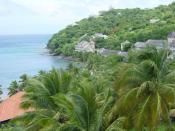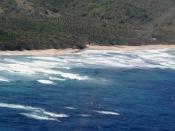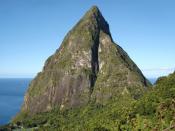Saint Lucia, an independent, island state, also one of the Windward Islands, West Indies, and Southeastern Caribbean Sea, between Martinique on the north and Saint Vincent on the south. It has an area of 238 squares miles. The Land, which is of volcanic origin, is covered from north to south by a forested mountain range that concludes in Mount Gimie. In the south, Soufriere, a volcanic crater with hot sulfuric springs, offers a very large source of geothermal energy. The mountains contain many streams and many fertile valleys. Saint Lucia has a tropical climate, with an average annual temperature of 79ð F. The average annual rainfall ranges from about 60 inches, on the coast to more than 100 inches in the mountains. The rainy season lasts from May to August. St. Lucia's culture is largely a matter of gaining some sense of the various peoples who have contributed to it.
The first of these were the Arawaks and the Caribs, Amerindian peoples indigenous to the entire Caribbean. They were expert hunters, farmers, fishermen, and skilled artists. Their primary crops were cassava, yams, sweet potatoes, all of which still play a central role in the island's food. The Amerindians were decimated by the arrival of the Europeans, and only a small number of St. Lucian's can still trace their roots back to this group. Some of the few particular aspects of Amerindian culture that survive include farina and cassava bread, fish-pots and other local craft items. Some villages still practice the ancient art of fishing in dugout canoes. The next to arrive on the shores of the island were the Europeans, primarily the British and the French. Though the Europeans didn't settle St. Lucia in large numbers, they had an incalculable impact on the island's history and culture. The...



Opinion
i found it very informative.
0 out of 0 people found this comment useful.